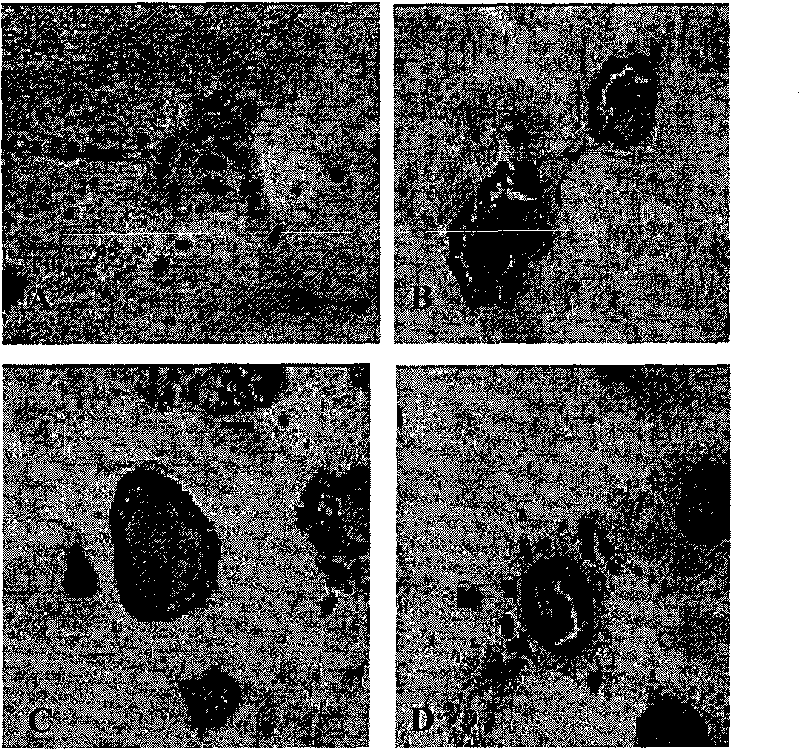Extracellular matrix gel model used for researching development and differentiation of embryonic stem cells
A technology of embryonic stem cells and extracellular matrix, applied in a series of key technical fields, can solve problems such as ignoring the development process
- Summary
- Abstract
- Description
- Claims
- Application Information
AI Technical Summary
Problems solved by technology
Method used
Image
Examples
Embodiment 1
[0034] Example 1. Construction of extracellular matrix gel three-dimensional scaffold in vitro
[0035] Mix type I liquid collagen and Matrigel glue evenly at a ratio of 4:1, then mix it with H-DMEM concentrated culture solution in equal volume, use an appropriate amount of 0.1M NaOH to adjust the pH of the mixture to 7.2-7.4, and add it to the prepared Inject 1ml into each well of a good 12-well plate mold. Place it at 37°C, 5% CO 2 Incubate at 5mim to 30mim in an incubator until the liquid complex is solidified to form a three-dimensional extracellular matrix gel model. This part of the operation is carried out on the ice box. exist figure 1 The lamellar-like three-dimensional differentiation and developmental model that can be seen in the formation.
Embodiment 2
[0036] Example 2. Embryonic stem cells were uniformly compounded into the three-dimensional model of extracellular matrix gel at different densities:
[0037] Mix type I liquid collagen and Matrigel gel evenly at a ratio of 4:1, then mix it with H-DMEM concentrated culture solution containing different concentrations of ESC in equal volume, and adjust the pH value of the mixture to 7.2~ with an appropriate amount of 0.1M NaOH 7.4, add to the prepared 12-well plate mold, inject 1ml into each well. (This part of the operation is carried out on the ice box). Place it at 37°C, 5% CO 2 When incubating in the incubator at 5mim to 30mim, after the liquid complex is solidified, add 1ml of ESC full culture medium without LIF to each well. Change the solution every day and observe. From figure 2 We can see that 10 4 The cell seeding density is too low, and the cells cannot survive; 10 7 The cell seeding density is too high, and there are a large number of cells; while at 10 5 -1...
Embodiment 3
[0038] Example 3. Research on induced differentiation and development of embryonic stem cells:
[0039] In the three-dimensional differentiation and development model of embryonic stem cells in vitro, different inducers were added to observe the ability of embryonic stem cells to differentiate and develop into different adult cells. Take the addition of V-C inducer as an example, add (0.1 mg / ml) V-C to the three-dimensional model that has been compounded with embryonic stem cells, and observe its effect on the formation of embryonic stem cells and their later differentiation and development. Figure 4 Embryonic stem cells were shown to form embryoid bodies and differentiate to form beating cardiac syncytium-like structures, and cTnT staining, a specific staining of the myocardium, revealed undifferentiated cardiomyocytes.
PUM
| Property | Measurement | Unit |
|---|---|---|
| diameter | aaaaa | aaaaa |
Abstract
Description
Claims
Application Information
 Login to View More
Login to View More - R&D
- Intellectual Property
- Life Sciences
- Materials
- Tech Scout
- Unparalleled Data Quality
- Higher Quality Content
- 60% Fewer Hallucinations
Browse by: Latest US Patents, China's latest patents, Technical Efficacy Thesaurus, Application Domain, Technology Topic, Popular Technical Reports.
© 2025 PatSnap. All rights reserved.Legal|Privacy policy|Modern Slavery Act Transparency Statement|Sitemap|About US| Contact US: help@patsnap.com



